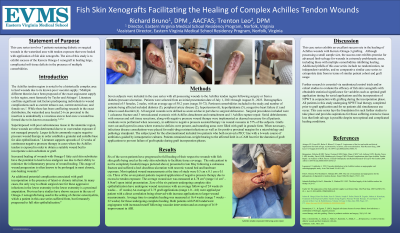Case Series/Study
(CS-034) Fish Skin Xenografts Facilitating the Healing of Complex Achilles Tendon Wounds

Trenton Leo, D.P.M.
Introduction: The Achilles tendon region is noted to be a historically complex area to heal wounds due to its known poor vascular supply. Multiple different theories have been proposed of the exact angiosome supply to this region, most famously by Taylor and Attinger. While there has been conflicting research in the exact distribution, the watershed area located 2-6 cm proximal to the insertion is undoubtedly a vexatious area to heal once a wound has formed. This case series exemplifies 7 patients sustaining wounds in the watershed area with tendon exposure that were healed with application of fish skin xenografts.
Methods: Seven patients exhibiting heel wounds from a multitude of pathologies including surgical wounds, pressure injuries, or infections were included. All seven patients underwent formal surgical debridement and at least one graft placement. Single grafts were cut and layered as needed in cases which were indicated. For cases requiring more than one graft application, this was completed on average every three weeks. Comorbidities including diabetes, peripheral arterial disease and osteomyelitis were also present in the case series. Negative pressure wound therapy was implemented as needed for severe soft tissue deficits. Wounds were considered healed after reulceration was not encountered after 3 months. Patients remained completely nonweightbearing until complete healing was achieved.
Results: All 7 patients proceeded to undergo complete healing with implementation of at least one fish xenograft application. The graft showed excellent success in various wound types as noted previously, showing versatility for multiple wound types, especially those with suboptimal vascular supply. At time of most recent follow-up patients were healed on average for 7.3 months with one patient undergoing reulceration 8 months following complete and sustained healing of the wound.
Discussion: This case series displays great success in the healing of complex wounds in a known area of difficult healing. These wounds should have a very low threshold to pursue grafting due to the propensity to become stagnant and the potential for bacteria to track the large tendon and advance into bone. Failure to treat these wounds diligently can result in severe loss of function as well as proximal amputations in severe cases. Future retrospective studies with a higher study population and perhaps a more standardized patient population could provide further insight on the success of fish skin xenografts with success in healing Achilles wounds with tendon exposure.
Trademarked Items:
References: Attinger CE, Evans KK, Bulan E, Blume P, Cooper P. Angiosomes of the foot and ankle and clinical implications for limb salvage: reconstruction, incisions, and revascularization. Plast Reconstr Surg. 2006 Jun;117(7 Suppl):261S-293S. doi: 10.1097/01.prs.0000222582.84385.54.
Lagergren C, Lindholm A. 1959. Vascular distribution in the Achilles tendon; an angiographic and microangiographic study. Acta Chir Scand 116:491–495.
Pufe T, Petersen WJ, Mentlein R, Tillmann BN. 2005. The role of vasculature and angiogenesis for the pathogenesis of degenerative tendons disease. Scand J Med Sci Sports 15:211–222.
Schmidt-Rohlfing B, Graf J, Schneider U, Niethard FU. 1992. The blood supply of the Achilles tendon. Int Orthop 16:29–31.
Taylor GI. The angiosomes of the body and their supply to perforator flaps. Clin Plast Surg. 2003 Jul;30(3):331-42, v. doi: 10.1016/s0094-1298(03)00034-8.
Methods: Seven patients exhibiting heel wounds from a multitude of pathologies including surgical wounds, pressure injuries, or infections were included. All seven patients underwent formal surgical debridement and at least one graft placement. Single grafts were cut and layered as needed in cases which were indicated. For cases requiring more than one graft application, this was completed on average every three weeks. Comorbidities including diabetes, peripheral arterial disease and osteomyelitis were also present in the case series. Negative pressure wound therapy was implemented as needed for severe soft tissue deficits. Wounds were considered healed after reulceration was not encountered after 3 months. Patients remained completely nonweightbearing until complete healing was achieved.
Results: All 7 patients proceeded to undergo complete healing with implementation of at least one fish xenograft application. The graft showed excellent success in various wound types as noted previously, showing versatility for multiple wound types, especially those with suboptimal vascular supply. At time of most recent follow-up patients were healed on average for 7.3 months with one patient undergoing reulceration 8 months following complete and sustained healing of the wound.
Discussion: This case series displays great success in the healing of complex wounds in a known area of difficult healing. These wounds should have a very low threshold to pursue grafting due to the propensity to become stagnant and the potential for bacteria to track the large tendon and advance into bone. Failure to treat these wounds diligently can result in severe loss of function as well as proximal amputations in severe cases. Future retrospective studies with a higher study population and perhaps a more standardized patient population could provide further insight on the success of fish skin xenografts with success in healing Achilles wounds with tendon exposure.
Trademarked Items:
References: Attinger CE, Evans KK, Bulan E, Blume P, Cooper P. Angiosomes of the foot and ankle and clinical implications for limb salvage: reconstruction, incisions, and revascularization. Plast Reconstr Surg. 2006 Jun;117(7 Suppl):261S-293S. doi: 10.1097/01.prs.0000222582.84385.54.
Lagergren C, Lindholm A. 1959. Vascular distribution in the Achilles tendon; an angiographic and microangiographic study. Acta Chir Scand 116:491–495.
Pufe T, Petersen WJ, Mentlein R, Tillmann BN. 2005. The role of vasculature and angiogenesis for the pathogenesis of degenerative tendons disease. Scand J Med Sci Sports 15:211–222.
Schmidt-Rohlfing B, Graf J, Schneider U, Niethard FU. 1992. The blood supply of the Achilles tendon. Int Orthop 16:29–31.
Taylor GI. The angiosomes of the body and their supply to perforator flaps. Clin Plast Surg. 2003 Jul;30(3):331-42, v. doi: 10.1016/s0094-1298(03)00034-8.

.png)